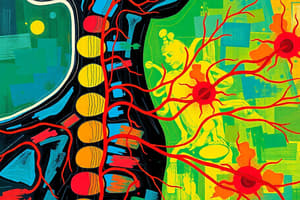Podcast
Questions and Answers
Which tract originates from the Chief sensory nucleus?
Which tract originates from the Chief sensory nucleus?
- Dorsal spinocerebellar
- Lateral spinothalamic
- Spinothalamic tract (correct)
- Spinoreticular tract
What type of sensation does the Ventral spinocerebellar tract convey?
What type of sensation does the Ventral spinocerebellar tract convey?
Subconscious kinesthetic sensations
The Dorsal spinocerebellar tract crosses in the spinal cord.
The Dorsal spinocerebellar tract crosses in the spinal cord.
False (B)
What is the function of the Spinotectal tract?
What is the function of the Spinotectal tract?
Where does the Spinoreticular tract terminate?
Where does the Spinoreticular tract terminate?
Which tract is associated with pain and temperature sensations?
Which tract is associated with pain and temperature sensations?
The Fasciculus cuneatus is located in the ______ and conveys ______.
The Fasciculus cuneatus is located in the ______ and conveys ______.
What is the function of the Anterior (ventral) spinocerebellar tract?
What is the function of the Anterior (ventral) spinocerebellar tract?
Which of the following tracts has its nucleus location in the nucleus gracilis?
Which of the following tracts has its nucleus location in the nucleus gracilis?
The Spinomesencephalic tract is located in the anterior column of the spinal cord.
The Spinomesencephalic tract is located in the anterior column of the spinal cord.
Flashcards are hidden until you start studying
Study Notes
Spinal Cord Tracts
- Spinal cord tracts are bundles of nerve fibers within the white matter of the spinal cord that transmit sensory information to the brain.
- The tracts are categorized by their location within the white matter:
- Posterior White Column
- Lateral White Column
- Anterior White Column
- Tract Pathways: There are two main sensory pathway categories, categorized by the location of their origin:
- Posterior Nerve Root Ganglion: These pathways begin in the dorsal root ganglion, a structure in the spinal cord where sensory nerve fibers converge.
- Substantia Gelatinosa: These pathways originate in the substantia gelatinosa, a region of gray matter within the dorsal horn of the spinal cord.
- Tract Classification: Pathways are further characterized by their function and location within the spinal cord. For example:
- Fasciculus gracilis and Fasciculus cuneatus are located in the Posterior White Column and transmit information about fine touch, vibration, and proprioception (sense of body position).
- Spinothalamic tract is located in the Lateral White Column and transmits information about pain and temperature.
- Spinocerebellar tracts are located in the Lateral White Column and transmit information about unconscious proprioception, which is the sense of muscle and joint position that is not consciously perceived.
- Tract Course: The course of a tract describes how the fibers travel. Some tracts are crossed, meaning they cross the midline of the body, while others are uncrossed.
- Tract Termination: Each tract ends in a specific area of the brain, where the information is processed.
- Thalamus: This is the main relay center for sensory information in the brain.
- Cerebellum: This structure plays a role in coordination and balance.
Key Ascending Spinal Cord Tracts
- Posterior (Dorsal) Columns
- Gracile fasciculus: transmits information about fine touch, vibration, and proprioception from the lower body.
- Cuneate fasciculus: transmits information about fine touch, vibration, and proprioception from the upper body.
- Anterolateral System
- Spinothalamic tract: transmits information about crude touch, pain, and temperature.
- Spinoreticular tract: transmits information related to behavioral response to pain and arousal.
- Spinomesencephalic tract: involved in central modulation of pain.
- Spinotectal tract: controls turning of the head and eyes towards a painful stimulus and autonomic response to pain.
- Spinohypothalamic tract: mediates autonomic response to pain.
- Spinocerebellar Tracts
- Posterior (dorsal) spinocerebellar tract: transmits information about unconscious proprioception from the lower body.
- Cuneocerebellar tract: transmits information about unconscious proprioception from the upper limb and head.
- Anterior (ventral) spinocerebellar tract: transmits information about unconscious proprioception from the lower body.
- Spino-olivary tract: transmits information about proprioception.
Key Considerations
- Decussation: Many spinal cord tracts decussate, which means they cross the midline. For example, the spinothalamic tract crosses at the level of the spinal cord.
- Location Within the Spinal Cord: Tracts are organized precisely within the white matter of the spinal cord. This organization allows for efficient transmission and processing of various types of sensory information.
- Function: Each tract carries a specific type of sensory information. This specificity is important for the brain to interpret the information accurately.
Studying That Suits You
Use AI to generate personalized quizzes and flashcards to suit your learning preferences.




